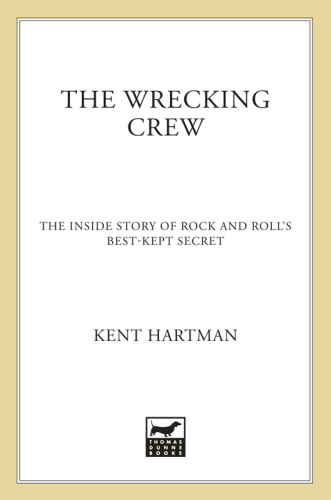
The Wrecking Crew
The Inside Story of Rock and Roll's Best-Kept Secret
- اطلاعات
- نقد و بررسی
- دیدگاه کاربران
نقد و بررسی

January 9, 2012
From 1962 to 1975, one group of studio players, the Wrecking Crew, provided the tracks for records as various as “He’s a Rebel,” “Surfer Girl,” “California Dreamin’,” “MacArthur Park,” ”Classical Gas,” and “Bridge over Troubled Water.” Industry insider Hartman opens our eyes to this fascinating group of musicians, tracing the careers of three members of this group—Glen Campbell, Carol Smith, Hal Blaine—who shared little more than an innate inner drive, musical talent, and a work ethic shaped by grinding poverty. Campbell, for example, lit out on the road when he was 13 to play guitar. Eight years later, Campbell joined the Champs, whose “Limbo Rock” Chubby Checker would soon record as “The Twist.” In 1962, Phil Spector gathered Campbell, Smith, Blaine, Billy Strange, Bill Pitman, and seven other highly skilled session musicians to lay down the tracks for “Zip-a-Dee-Do-Dah,” added the voices of Bob B. Soxx and the Blue Jeans, and a #1 record and the Wrecking Crew were born. Hartman also traces the work of later members of the Crew such as Leon Russell, Larry Knechtel, and Jim Gordon, as well as the successful solo careers of Campbell and Russell. Hartman’s fast-paced tale offers dazzling insights into a little known chapter of rock and roll history.

November 15, 2011
The saga of the first-call Los Angeles session musicians who powered some of the biggest hits of the 1960s and '70s. In truth, the Wrecking Crew isn't the secret it once was: Drummers Hal Blaine and the late Earl Palmer penned books about their lives in the studio, and a documentary about the unit by Denny Tedesco, son of Crew guitarist Tommy Tedesco, has made film festival rounds. It's nonetheless a fascinating story, albeit one not always well served by Hartman's approach. After kicking off with background on three key players--Blaine, bassist Carol Kaye and guitarist/pop star-to-be Glen Campbell--the author delineates the group's genesis as top-paid hired guns on producer Phil Spector's elaborate "Wall of Sound" sessions. Subsequently, a core unit of adept but uncredited pros became go-to backup musicians for a seemingly endless round of L.A. record dates, playing behind acts ranging from the Beach Boys to Simon & Garfunkel. Hartman notes that in the Crew's heyday, record labels called the shots, and groups like the Byrds, the Monkees, the Union Gap and the Association were compelled to reluctantly drop their instruments in favor of the anonymous studio aces' polished work. Only after the wind shifted in the '70s in favor of self-contained bands did the Crew's impact wane, and its members moved on to film and TV gigs. Hartman makes a compelling case for the skill of his subjects, who often fabricated the crucial hooks that brought their clients fame. Some chapters, such as one about the recording of "Bridge Over Troubled Water," are rich in fly-on-the-wall detail. However, the musicians frequently disappear within their own story, as Hartman chooses to focus on others, like producer Jimmy Bowen and songwriter Jimmy Webb, who played major roles in hits they worked on. Some Crewmen, like drummer Jim Gordon, a schizophrenic who murdered his mother, receive in-depth treatment, but too many are names merely mentioned in passing. The book's greatest failure is the format, which weaves interview and source material into a novelistic structure with re-created dialogue that often falls flat. These gifted players sadly remain too faceless.
(COPYRIGHT (2011) KIRKUS REVIEWS/NIELSEN BUSINESS MEDIA, INC. ALL RIGHTS RESERVED.)

January 1, 2012
In Los Angeles in the 1960s-70s, if you wanted to record a chart-topping track or album, you called in the crack session musicians collectively known as the Wrecking Crew. Consisting of artists unknown outside the music industry, like drummer Hal Blaine and bass player Carol Kaye, as well as those who would go on to recording fame of their own, such as Glenn Campbell and Leon Russell, the Wrecking Crew was the West Coast's cream of the crop of session players, backing top-notch hit makers Phil Spector, Frank Sinatra, the Beach Boys, Simon & Garfunkel, and many more. Hartman (marketing, Portland State Univ.), who has worked with many well-known recording artists including Hall & Oates, Three Dog Night, and Lyle Lovett, tells the group's definitive story with a music industry insider's insight and enthusiasm. The only other work on these behind-the-scenes pros is Blaine's Hal Blaine and the Wrecking Crew, which is more narrowly focused on the experiences of the stalwart drummer. VERDICT Recommended for readers interested in popular music and the music industry, particularly West Coast pop and classic rock. [See Prepub Alert, 8/12/11.]--Dave Valencia, Seattle P.L.
Copyright 2012 Library Journal, LLC Used with permission.




دیدگاه کاربران